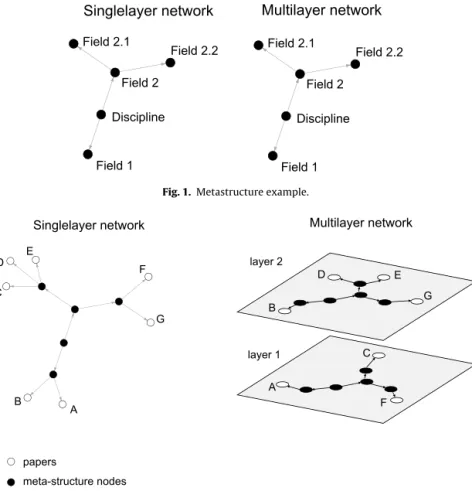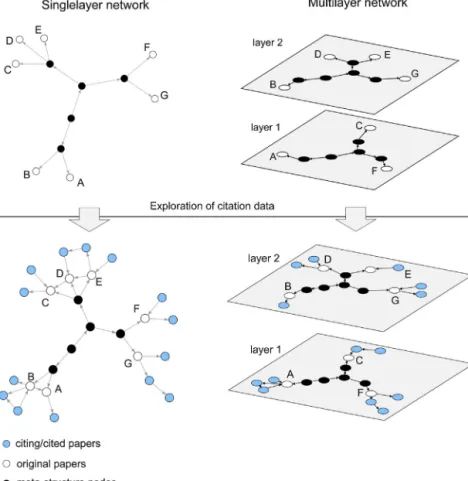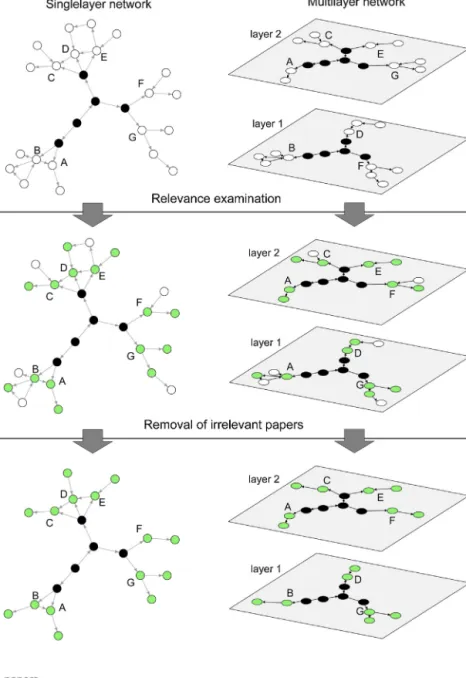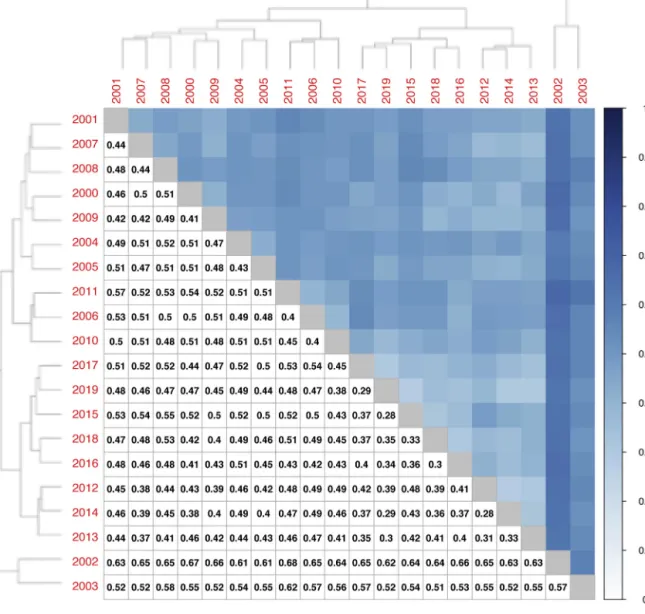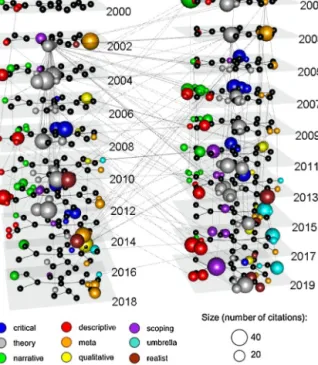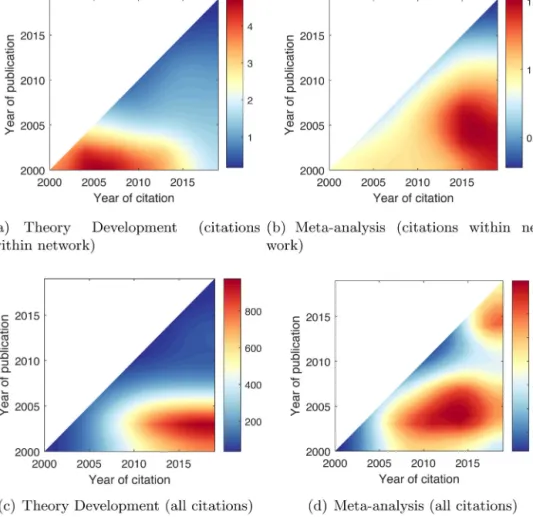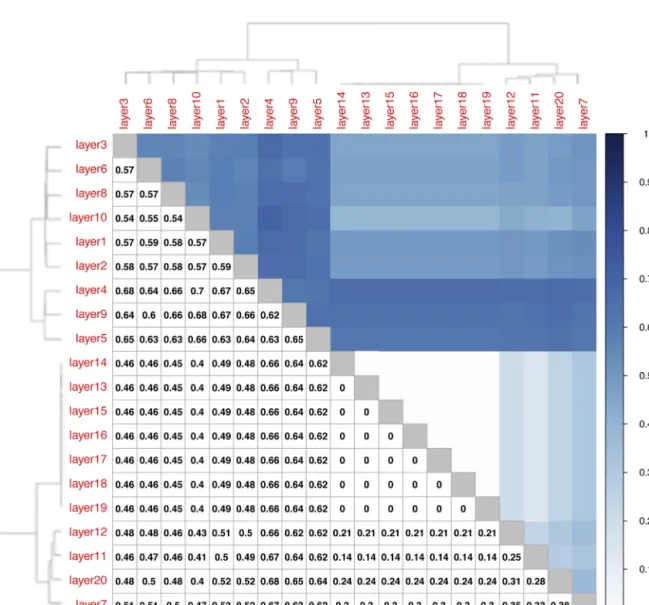JournalofInformetrics15(2021)101111
ContentslistsavailableatScienceDirect
Journal of Informetrics
j o ur na l h o me p a g e:w w w . e l s e v i e r . c o m / l o c a t e / j o i
Regular article
SIMILAR – Systematic iterative multilayer literature review method
Zsolt T. Kosztyán
a,c,d,∗, Tibor Csizmadia
b, Attila I. Katona
aaDepartmentofQuantitativeMethods,InstituteofManagement,FacultyofBusinessandEconomics,UniversityofPannonia,Hungary
bDepartmentofManagement,InstituteofManagement,FacultyofBusinessandEconomics,UniversityofPannonia,Hungary
cMTA-PEBudapestRankingResearchGroup,Hungary
dInstituteofAdvancedStudies,K ˝oszeg,Hungary
a rt i c l e i n f o
Articlehistory:
Received9July2020
Receivedinrevisedform8October2020 Accepted16November2020
Keywords:
Systematicliteraturereview Multilayernetworks Iterativeclassification Citationnetwork Informationsystems
a b s t ra c t
Asthenumberofpublishedscientificarticleshasincreasedexponentiallyandtheinterdis- ciplinarynatureofscientificresearchhasstrengthenedoverthepastdecades,theprocessof conductingefficientliteraturereviewshasplayedanincreasinglyimportantroleinhelping scholarsmakesenseofpreviousresearchresults.Althoughcurrentliteraturereviewmeth- odsprovideinsightfulresults,theyareeithercross-sectionalorlongitudinalstudiesandare unabletosimultaneouslymodelthestructureandevolutionofaresearchfield.Inaddition, onlyafewmethodsapplytheiterativerefinementoftheextractedcategories,andnone integratethepowerfulmultilayernetworktheoryduringtheliteraturereview.Tofillthis gap,thecurrentpaperdevelopsasystematiciterativemultilayerliteraturereview(SIMI- LAR)method.Theproposedmethodhelpsresearchersto(1)refinetheinitialclassification rulesoftheselectedpapersthroughiterations,(2)integratethemultilayernetworktheory intotheliteraturereviewprocess,andfinally(3)conductlongitudinalandcross-sectional analysesatthesametime.WedemonstratetheaddedvalueoftheSIMILARmethodby extendingresearchresultsrecentlyobtainedinthefieldofinformationsystems.
©2020TheAuthor(s).PublishedbyElsevierLtd.Thisisanopenaccessarticleunderthe CCBYlicense(http://creativecommons.org/licenses/by/4.0/).
1. Introduction
Themassiveemergenceand rapiddiffusionof knowledgebothwithinandacrossdisciplinesanddomainsrequires researcherstofindawaytoquicklysynthesizepriorresearch,addressrelevantgapsandstimulatefutureresearch.Recog- nizingthatcumulativeknowledgedevelopmentincreasinglyreliesontheintegrationofpreviousstudies,severalscholars havemadecallsformoreliteraturereviews(Bandara,Miskon,&Fielt,2011;Hunter,Schmidt,&Jackson,1982;Paré,Trudel, Jaana,&Kitsiou,2015;Pfeffer&Sutton,2006;Reay,Berta,&Kohn,2009;Rousseau,Manning,&Denyer,2008;Templier
&Paré,2015;Watson&Webster,2020).Conductingeffectiveliteraturereviewsplaysavitalrolenotonlyfortheirown knowledgecontributions,suchasadvancingtheknowledgeandunderstandingthebreadthoftheresearchonatopicof interest,synthesizingknowledge,buildingtheory,aggregatingempiricalevidence,andbecomingorientedinanemerging domain(Cohn&Becker,2003;Cooper,1988;Fink,2019;Mulrow,1994;Paréetal.,2015;Pfeffer&Sutton,2006;Rowe,2014;
∗ Correspondingauthorat:DepartmentofQuantitativeMethods,InstituteofManagement,FacultyofBusinessandEconomics,UniversityofPannonia, Hungary.
E-mailaddress:kzst@gtk.uni-pannon.hu(Z.T.Kosztyán).
https://doi.org/10.1016/j.joi.2020.101111
1751-1577/©2020TheAuthor(s).PublishedbyElsevierLtd.ThisisanopenaccessarticleundertheCCBYlicense(http://creativecommons.org/licenses/
by/4.0/).
Schryenetal.,2017),butalsofortheircapacitytostimulatesubsequentresearch,which,inturn,validatesandextendstheir contributions(Paréetal.,2015;Prester,Wagner,&Schryen,2018).
Aliteraturereviewcanbethebackgroundforaprimaryresearcharticle,apartofathesis,apartofaprojectproposal (Baker,2000),oranimportanttypeofpublicationinitsownright(standalonereview)(Schryenetal.,2017;Schwarz,Mehta, Johnson,&Chin,2007;Templier&Paré,2018).Inaddition,reviewarticlesfrequentlybecomecoreormilestonepapersina field(Paréetal.,2015).Literaturereviewshavebeenstudiedinseveralfields,suchashealthsciences(Grant&Booth,2009;
Liberatietal.,2009),management(Alvesson&Sandberg,2011;Zorn&Campbell,2006),nursing(Cronin,Ryan,&Coughlan, 2008;Whittemore,2005),psychology(Baumeister&Leary,1997),socialsciences(Hart,2018;Petticrew&Roberts,2008), andsoftwareengineering(Kitchenham&Charters,2007).Unsurprisingly,thediversityofdisciplineshasledtotheadoption ofseveralperspectivesonliteraturereviews,includingdefinitions(Blaxter,2010;Blumberg,Cooper,&Schindler,2005;Fink, 2019;Hart,2018;Rowe,2014;Watson&Webster,2020),purposes(Okoli,2012;Paréetal.,2015;Templier&Paré,2015), typesandclassifications(Grant&Booth,2009;Paréetal.,2015;Schryenetal.,2017),methodologicalapproaches(Sylvester, Tate,&Johnstone,2013;Wolfswinkel,Furtmueller,&Wilderom,2013)andreviewprocess(Croninetal.,2008;Hart,2018;
Petersen,Feldt,Mujtaba,&Mattsson,2008;Templier&Paré,2018).
Inthisarticle,wefocusonthemethodologicalaspectsoftheliteraturereview.Agrowingnumberofscholarshavecalled forsystematic,well-explicatedandrigorousmethodsthatenhancethevalueofliteraturereviews(e.g.Croninetal.,2008;
Kitsiou,Paré,Jaana,&Gerber,2017;Liu,Lu,Lu,&Lin,2013;Paréetal.,2015;Schryenetal.,2017;Templier&Paré,2018);
suchmethodshelpliteraturereviewstobecomenotonlymoreusefultothefieldbutalsomorereplicable(Templier&Paré, 2018;Wolfswinkeletal.,2013).Attemptsmadeinthisdirectionincludecitation-basedmethods(Liuetal.,2013;Marra, Emrouznejad,Ho,&Edwards,2015;Merigó,Pedrycz,Weber,&delaSotta,2018;Yu,Xu,Pedrycz,&Wang,2017),growth curveanalysis,groundedtheory(Wolfswinkeletal.,2013),thematicanalysis(Bandaraetal.,2011),andthehermeneutic framework(Boell&Cecez-Kecmanovic,2015).
Inaddition,algorithmic-assistedapproachesweredevelopedtosignificantlydecreasethemanualworkwhileconducting theliteraturereview.Brisebois,Abran,Nadembega,andN’techobo(2017)usedmachinelearningtoidentifyandbuildthe relevantliteraturecorpus.Xiongetal.(2018)conductedaliteraturereviewinwhichrelevantpaperswereclassifiedbythe maximumentropyalgorithm.YuandMenzies(2019)developedFAST2,anautomaticassistant,tohelpresearchersfindmore relevantpapersfaster.
Whileprovidinginsightfulresults,thesemethodshavesomeshortcomingsdespitethealgorithmicassistance.Theyare eithercross-sectionalorlongitudinalstudies,andtheydonotallowscholarstomodelthestructureandevolutionofa researchfieldatthesametime.Inaddition,currentcitationnetwork-basedsolutionsdonotrefinetheextractednetwork structureiterativelyduringtheliteraturesearch,andmultilayercitationnetworkshavenotyetbeenappliedinliterature reviews.
Inthispaper,wefillthisgapbyadvancingastate-of-the-artsystematiciterativemultilayerliteraturereview(SIMI- LAR)methodtohelpresearchersconductliteraturereviewswithouterror-proneandmethodologicalrigor.Specifically, weapplymultilayernetworkstoallowresearcherstoconductbothlongitudinalandcross-sectionalanalysesatthesame time. Furthermore,inthis method,more opportunitiesareavailablesince layerscanbedefinednot onlybythetime dimensionbut alsobasedonvariousfeatures suchasjournalquality orgeographical locationoftheresearchlabora- tory.
Assuch,thispapercontributestotheliteratureinthefollowingways:(1)weadoptanovelcitationnetwork-based literaturereviewmethod,whichallowsresearcherstoiterativelyrefinethepredefinedcategoriesfortheexaminedpapers andidentifyallrelevantpapersintheinvestigateddiscipline;(2)basedonanewexactprocedure,weextendthereview process with multilayernetwork theory; (3) we show that by highlighting thesignificance of identifyingthe emer- gence,growth,reductionandthenetworkofliteratureinadomainordiscipline,scholarscanconductlongitudinaland cross-sectional analysisat thesametime. Toevaluateand showtheadded valueof theSIMILARmethod,we extend theresearchresultsaddressedbyTemplierandParé(2018),whoconductedtheanalysisinthefieldofinformationsys- tems.
Therestofthispaperisorganizedasfollows.Section2providesthetheoreticalbackgroundofthestudy.Section3 introducestheproposedmethod.Section4presentsquantitativeresultsthroughanexampleinthefieldofinformation systemsresearch.Section5concludesthepaper.
2. Backgroundofthestudy
Theliteraturereviewprocessisanimportantpartofanyscientificpaperorresearch.Itisvalidtosaythatanappropriate andeffectiveliteraturereviewisnecessarytoobtainupdatedinformationaboutthelatestscientificresultsandtounderstand andidentifytheexistinggapswithintheselectedresearcharea(Hunteretal.,1982).Itisimportanttointroducehowour proposedmethodfitsintothetypologyoftheliteraturereviews,howitsupportstheproposedliteraturereviewprocesses andhowitcontributestotheexistingcitationnetwork-basedapproaches.Therefore,wediscusstherelatedworksinthree categories:(1)thetypologyofliteraturereviews,(2)theliteraturereviewprocessandguidelines,and(3)citationnetworks.
Z.T.Kosztyán,T.CsizmadiaandA.I.Katona JournalofInformetrics15(2021)101111 2.1. Typologyofliteraturereviews
Thetypologyofliteraturereviewshasbeenconstructedandexaminedbyseveralscholars.Furthermore,severalliterature reviewtypologieshavebeenconstructedbasedondifferentaspects(Templier&Paré,2015).Inthissubsection,weintroduce thefrequentlyappliedtypologies.
Cooper(1985)categorizedliteraturereviewsbasedonthefocus,goal,perspective,coverage,organization,andaudience ofthepapers.Cook,Mulrow,andHaynes(1997)distinguishedbetweennarrativeandsystematicliteraturereviews.The structureofsuchreviewswaslaterrefined,andsystematicreviewswerefurtherdistinguishedintoqualitativesystematic literaturereviewsandquantitativesystematicliteraturereviews(ormeta-analyses),asdescribedbyGreen,Johnson,and Adams(2006),whoalsodiscussedthedifferentsubcategoriesofnarrativereviews.AnothertypologywasusedbyCronin etal.(2008),wherenotonlymeta-analysisbutalsometasynthesiswasdescribedasanonstatisticalmethodwiththeaim ofintegratingtheoutcomeofmultiplequalitativeliteraturereviews.
Theaforementionedtypologiesweredevelopedinthemedicalresearcharea;however,thetypologyofliteraturereviews isalsoafrequentlydiscussedtopicintheresearchfieldofinformationsystems(Bandaraetal.,2011;Templier&Paré,2018).
Rowe(2014)classifiedtheliteraturereviewsacrossfourdimensions:goalwithrespecttotheory,breadth,systematicity, andargumentativestrategy.Paréetal.(2015)extendedthisstructureandprovidedamoredetailedtypologyincludingnine reviewtypes(seeashortdescriptionofeachtypeinTable1).Later,thetwoschemeswerenested,andacombinedtypology wasdeveloped(Templier&Paré,2018).
Toshowthecontributionofourmethodtothedifferentliteraturereviewtypes,wewillusethecombinedtypologyused byTemplierandParé(2018)becauseitisnewlydevelopedandduetoitscombinationoftwotypologies,itcoversmultiple aspects.
2.2. Literaturereviewprocessandguidelines
Notonlytypologiesbutalsoseveralguidelineshavebeenprovidedtosupportscholarsintheliteraturereviewcon- structionprocess.In1982,Cooperdevelopedscientificguidelinesforconductingintegrativeresearchreviews.Hismodel includedfivesteps:(1)problemformulation,(2)datacollection,(3)dataevaluation,(4)analysisandinterpretation,and(5) publicpresentation(Cooper,1982).Althoughthisresearchfocusedonthereviewprocessofpsychologicalsciences,strong literaturereviewmethodologiesweredevelopedlaterinotherdisciplinesaswell(Templier&Paré,2015),suchashealth sciences(seeAveyard,2014;Hewitt-Taylor,2017;Higgins&Green,2011;Liberatietal.,2009),softwareengineering(see Brereton,Kitchenham,Budgen,Turner,&Khalil,2007;Kitchenham&Charters,2007;Petersenetal.,2008),management sciences(Durach,Wieland,&Kembro,2014;Rousseauetal.,2008)andinformationsystems(Okoli,2015;Okoli&Schabram, 2010).
In2007,KitchenhamandCharters(2007)concludedthatthreemainphasesneedtobeincludedtoprovideaneffective literaturereview:(1)planning,(2)carryingoutand(3)reporting.Thefirstphasecontainstheformulationoftheresearch questionanddesignofthereviewmethodology.Thecarryingoutphaseincludesseveraltasks,suchascollecting,validating, andevaluatingpapersandanalyzingresults.Thereportingphasereferstothewritingoftheliteraturereviewbasedonthe outcomeoftheprevioussteps(Kitchenham&Charters,2007;Templier&Paré,2015).
Thefundamentalframeworkwaslaterrefinedbyextendingittoasix-stepprocessasfollows:(1)formulatingtheproblem, (2) searchingforliterature,(3)screeningforinclusion, (4)accessingquality,(5)extractingdataand (6)analyzingand synthesizingdata(Templier&Paré,2015).
Thispaperproposesacitationnetwork-basedsystematicliteraturereviewprocessthatallowstheresearchertoiteratively refinethepredefinedcategoriesfortheexaminedpapersandidentifyallrelevantstudiesintheinvestigatedresearchfield.
2.3. Citationnetworks
TheanalysisofcitationnetworkshasitsoriginsintheworkofGarfield,Sher,andTorpie(1964),whoshowedthata strongpatterncanbeobservedbetweenhistoricaldescriptioneventsandcitationaldatarelatedtotheevents.Later,the analysisopportunitiesbycitationnetworkanalysiswereextendedthroughtheresearchworkofHummonandDoreian.
Theseauthorsproposedgraphindicesthathelptoidentifythemostimportantsubgraphofthecitationnetwork(Hummon
&Dereian,1989;Hummon&Doreian,1990;Hummon,Doreian,&Freeman,1990).In2003,Batagelj(2003)proposedan improvementregardingtheaforementionedindices,whichallowedresearcherstoapplythemtolargecitationnetworks.
Inthefollowingyears,theidentificationofthemostinfluencingarticleswithinthecitationnetworkbecameanoutstanding researcharea(seeBergsma,Mandryk,&McCalla,2014;Davletov,Aydin,&Cakmak,2014;delaPena,2011;Hong&Do, 2018;Huangetal.,2018;Pichardo-Corpus,Contreras,&delaPe ˜na,2019;Su,Sun,Xuan,&Shi,2015).Thevisualizationand analysisofcitationnetworksarealsosupportedbyseveralsolutions,suchasVOSviewer(Leydesdorff,Carley,&Rafols,2013;
Leydesdorff&Rafols,2012),HistCite(Garfield,2009;Lucio-Arias&Leydesdorff,2008)orCiteNetExplorer(Maheswaran, 2019).Nevertheless,thesesolutionsdonotallowusingmultilayernetworks.Theanalysisofresearchtrendswithcitation networksalsoreceivedoutstandingattention;however,theproposedmethodsareeitherlongitudinalonlyorcompare thecross-sectionalresultsoftwoperiods(e.g.,Asatani,Mori,Ochi,&Sakata,2018;Benckendorff,1994;Dawson,Gaˇsevi ´c, Siemens,&Joksimovic,2014;Ho,Saw,Lu,&Liu,2014).Inthispaper,wedevelopacitationnetwork-basedliteraturereview
3
Table1
Descriptionoftheliteraturereviewtypes.
Type Description Example
Narrative Narrativereviewsattempttoidentifywhathasbeenwrittenona subjectortopic.Theysummarizetheextantliteratureandprovide acomprehensivereportonthecurrentstateofknowledgeonthe topicofinterest.Theyusuallyselectivelyfocusonliteratureand evidencethatarereadilyavailabletoresearchers.
Aloini,Dulmin,andMininno(2007)
Descriptive Descriptivereviewsinvestigatematuretopicsandaimat determiningtheextenttowhichabodyofempiricalstudies revealsanyinterpretablepatternsortrendsoveragivenperiodof time.Theycollectandanalyzenumericdatathatreflectthe frequencyofthetopics,authorsormethodsfoundintheextant literature.Structuredsearchmethodsaretypicallyusedtoforma representativesampleofalargergroupofpublishedworksthat arerelatedtoaparticularareaofinvestigation.
Avison,Dwivedi,Fitzgerald,andPowell(2008)
Scoping Scopingreviewsareprimarilyconcernedwithemergenttopics andaimatassessingthesizeandscopeoftheavailableliterature andinformingresearchersaboutanewarea.Theyusuallyaddress abroadspectrumoftopics,wheremanydifferentstudydesigns mightbeapplicable.Scopingreviewsusuallyconcludewith potentialimplicationsforpracticeandresearch.
Archer,Fevrier-Thomas,Lokker,McKibbon, andStraus(2011)
Critical Criticalreviewsaimtocriticallyanalyzetheextantliteratureona broadtopictorevealweaknesses,contradictions,controversies,or inconsistencies.Theyattempttotakeareflectiveaccountofthe researchthathasbeendoneinaparticularareaofinterestand assessitscredibilityusingappraisalinstrumentsorothermethods.
Criticalreviewsareeitherselectiveorrepresentativeandrarely involveacomprehensivesearchofalloftherelevantliterature.
Schryen(2013)
Meta-analysis Meta-analysesusespecificdataextractiontechniquesand statisticalmethodstosummarizeandsynthesizepriorempirical resultsonagiventopic.Meta-analysesprovidepreciseestimates ofrelationsbetweenvariablesbecausetheyadjustforthesample sizeandreliabilityofmeasures.Theyareconsideredtobea powerfulmethodofsynthesisthatallowsresearcherstodraw meaningfulinferencesbysettlingexistingcontroversiesthatarise fromconflictingempiricalstudies.
OrtizdeGuinea,Webster,andStaples(2012)
Qualitativesystematic Qualitativesystematicreviewsusenarrativemethodstobring togetherthequantitativefindingsofagroupofheterogeneous studies.Theyemploythetypicalsystematicreviewprocessbutuse narrativeandmoresubjectivemethodstobringtogetherthe findingsoftheincludedstudies.Thedefiningelementof qualitativesystematicreviewsistheadoptionofatextual approachintheprocessofanalysisandsynthesis.
Petter,DeLone,andMcLean(2008)
Umbrella Umbrellareviewsaimatsynthesizingthefindingsofprior reviews.Theyintegraterelevantevidencefrommultiple systematicreviewsintooneaccessibleandusabledocumentto addressanarrowresearchquestion.Umbrellareviewsappraise themethodologicalrigorandqualityofevidenceofsystematic reviewsbymeansofexplicitcriteria.
Mbemba,Gagnon,Paré,andCôté(2013)
Theorydevelopment Theoreticalreviewsdrawonexistingconceptualandempirical studiestoprovideacontextforidentifying,describing,and transformingintoahigherorderoftheoreticalstructureand variousconcepts,constructsorrelationships.Theybringtogether diversestreamsofworkandusevariousstructuredapproaches suchasclassificationsystems,taxonomiesandframeworksto organizepriorresearcheffectively,examinetheir
interrelationships,anddiscoverpatternsorcommonalitiesthat willfacilitatethedevelopmentofnewtheories.
vonKrogh,Haefliger,Spaeth,andWallin(2012)
Realist Realistreviewsaretheory-driveninterpretativereviewsthat inform,enhance,extendoralternativelysupplementconventional systematicreviewsbymakingsenseofheterogeneousevidenceof complexinterventionsappliedindiversecontexts.Theyusually startbyarticulatinglikelyunderlyingmechanismsandthen scrutinizeavailableevidencetodeterminewhetherandwhere thesemechanismsareapplicable.
Wong,Greenhalgh,andPawson(2010)
Z.T.Kosztyán,T.CsizmadiaandA.I.Katona JournalofInformetrics15(2021)101111 methodthatcanbeextendedtoamultilayerstructureinwhichlongitudinalandcross-sectionalanalysiscanbeconducted atthesametime.
3. Methods
InSection3.1,theappliedtermsanddefinitionsarepresented.InSection3.2,thestepsoftheproposedmethodare shown.Finally,inSection3.3,theoperationalizationoftheproposedmethodisintroduced.
3.1. Termsanddefinitions
Graph:GraphisatupleG=(V,E),whereVisasetofnodes(V={v1,v2,...,vn})andEissetofedgeswhereeijrepresents theedgebetweennodesviandvj(i,j∈{1,...,n},nisthenumberofnodes).Differentmetricscanbeusedtodeterminethe
“importance”ofthepapersortocharacterizeeachcategory(inotherwords,agroupofspecificstudies)acrossthecitation network.Forthispurpose,weusedensity,numberofcomponentsandmeanpathlength.
Graphdensity:Densitycanbecalculatedasfollows:
D= a
n(n−1)/2 (1)
whereaisthenumberofactualedgesinagraph(orsubgraph),andn(n−1)/2denotesthepossiblenumberofedgesamong thennodesofthegraph.Weusegraphdensitytomeasurehowthestudiesinaparticulararearelyoneachother’soutcomes (citeeachother).
Connectedgraph:Agraphisconnectedifithasapathbetweeneverypairofnodes.
Numberofcomponents:IfGisagraphwithHsubgraph,thenHisacomponentofGif(1)itisconnectedand(2)H isnotconnectedtoanyconnectedsubgraphofG(Chartrand,1977).Thenumberofcomponentsrevealsinformationabout isolatedresearchwithinaspecificpartofaresearchfield.
Meanpathlength:Meanpathlength(lG)canbecalculatedasfollows:
lG= 1 n(n−1)
i=/j
d(vi,vj) (2)
where d(vi,vj)istheshortestpathbetweennodes viand vj. Thismetricis usedtocharacterizethelength(speed)of informationspreadingacrossthespecificresearchsubarea(subgraph).
Multilayernetwork:Theproposedmethodbasedonamultilayernetworkanalysis,whereamultilayernetworkisapair M=(G,C)G={G˛=(V˛,E˛),˛ ∈{1,...,M}}isafamilyof(directedorundirected,weightedorunweighted)graphs (calledlayersofM),V˛isthesetofnodes(vertices),E˛isthesetofedges(arcs)ofgraphG˛,andthefollowing:
C={E˛,ˇ⊆V˛×Vˇ,˛,ˇ ∈{1,...,M},˛=/ˇ} (3) isthesetofinterconnectionsbetweennodesofdifferentlayersG˛andGˇwith˛ =/ ˇ.
Reducibilityofmultilayernetwork:Thenumberoflayersinthemultilayercitationnetworkisanimportantquestion.
Todeterminetheoptimalnumberoflayers,wefollowtheapproachdevelopedbyDeDomenico,Nicosia,Arenas,andLatora (2015),whousedtheJensen–Shanondivergencetomeasurethepairwisesimilaritybetweenthelayers.TheJensen–Shanon divergence(DJS)isamodificationoftheKullback–Lieblerdivergence(DKL).Letandbetwodensitymatriceswith respecttotwodifferentlayers(G˛andGˇ);then,DKLcanbedescribedasfollows:
DKL()=Tr[(log2(−log2())] (4)
Trdenotesthetraceofthesquarematrix,whichisthesumofallelementsinthemaindiagonalofthematrix.SinceDKLis notsymmetric(DKL()=/DKL()),DJSisusedinsteadasfollows:
DJS()= 1
2DKL()+1
2DKL() (5)
Theresultscanbeillustratedthroughadendrogramindicatinghowtheinitialstructurecanbeaggregated.Reducibility analysisisveryimportantbecauseitdeterminestheunitofanalysis,e.g.,theoptimalstepsizeifcitationnetworklayersare constructedbasedontime.
3.2. Stepsoftheproposedmethod
Theproposedmethodconsistsofthefollowingfourfundamentalsteps:
1.Metastructuresearch
2.Explorationofcitationnetwork 3.Relevanceexamination 4.Classification
5
Fig.1. Metastructureexample.
Fig.2.Metastructurewithconnectedpapers.
Table2providesanoverviewofthestepsoftheproposedapproach.
Step1:Metastructuresearch.Inthefirststep,apublishedandrelevantliteraturereviewmustbeselectedforuseas aninitialpointforthecurrentliteraturereviewprocess.Theselectedliteraturereviewmustcontaintheclassificationof reviewedarticlesbecauseitsclassificationruleswillbeusedandfurtherexpandedorimprovedintheremainingstepsif necessary.Inthispaper,werefertotherulesofclassificationas“metastructure”.Thismetastructurewillbeexpandedand validatediterativelyduringtheapplicationoftheproposedmethod.Nodesrepresentdifferentresearchareaswithinthe selecteddiscipline,andedgesrepresentthestructureamongthem(Figs.1and2).
Classifiedpapersbasedontheselectedliteraturereviewneedtobeconnectedtothebuiltmetastructure.Basically,this stepsummarizesandvisualizestheresultsgivenbytheinitialliteraturereview.
Step2:Explorationofthecitationnetwork.Thesecondstepistheexplorationofthecitationnetworkaccordingtothe derivedmetastructureanditsclassifiedpapers.Alistofcitingpapersmustbecollectedforalltheinitiallyclassifiedpapers (fromstep1)withoutconsiderationofrelevance,sinceirrelevantpapers(nodes)willberemovedaspartofafurtherstep.
Notonlycollectionbutalsoconnectiontotheappropriatenodesisnecessary.Letnode“A”representtheclassifiedpaperby theinitialliteraturereviewandnode“B”representoneelementofthelistofcitingarticlesregardingnode(paper)“A”.In thiscase,adirectededgeneedstobedrawnpointingfromnode“B”to“A”,indicatingthatpaper“A”wascitedbypaper“B”.
Thisstepmustbeconductedforallthepapers(nodes),includingthoseintheinitiallyselectedliteraturereview(Fig.3).
Step3:Relevanceexamination.Inthisstep,therelevanceoftheexploredcitingpapersisexamined,andirrelevant papersmustberemovedfromtheconstructedcitationnetwork(givenbystep2).Tojudgetherelevanceofthecollected papers,thetitles,abstracts,keywordsandcontentcanbeused.Althoughthisstepistimeintensive,thereisanopportunity forfurtherresearchtobuildmachinelearning-basedclassifierstosupportthistaskanddecidewhethertheexaminedpaper isrelevantfromtheperspectiveoftheliteraturereview(Fig.4).
Step4:Classification.Thelaststepisclassification,wheretheconstructedcitationnetworkneedstoberevised.Each connectedpapermustbeanalyzedintermsofitsrelationtothemetastructure.Iftheithpaper’stopicfitstothearea describedbythepathofthemetastructure,thenitslocationcanbekept.Otherwise,ifitstopicisanewareawithinthe analyzeddiscipline,thepathwithinthemetastructure(thatincludesthecurrentpaper)needstoberevised.Thefollowing actionscanbemade:
•Createanewresearcharea
Z.T.Kosztyán,T.CsizmadiaandA.I.KatonaJournalofInformetrics15(2021)101111
Table2
Stepsoftheproposedapproach.
Nr Step Description Assumption Outcome Stoppagecriteria Opportunitiesto
support 1 Findingarelevant
literaturereview.
Apublishedandsuitableliteraturereview mustbefound,whichalsodescribesthe typology/classificationofapproachesinthe selectedresearchtopic.Ifmorereviewscanbe found,theresearchercandecidetousethe(1) unionor(2)thesetofmultipleliterature reviews,or(3)themostsuitable/citedreview canbeselected.
Atleastoneliterature reviewexistsinthe studiedresearchfield thatdescribesthe typologyoftheofthe selectedresearchtopic.
1.Ametastructurethat describesthetypology oftheselectedresearch topic.2.Asetof classifiedpapersbased ontheselected metastructure.
1.Anappropriateliterature reviewwasfoundwithsuitable classificationrules2.An appropriateliteraturereview wasselectedfromseveral candidates.
GoogleScholar keywordsearch.
Specificterms:
literaturereview survey.
2 Explorationofthe citationnetwork.
Thecitationlistmustbeextractedforallthe categorizedpapersgivenbytheliterature reviewdefinedatstep1.Inthisway,the numberofcategorizedpaperswillbe increasedsignificantly.Thelistofcitingand citedarticlesmustbestoredinordertoensure alltherelevantpapersareincludedinthis expandeddataset.
Citationinformation mustbeknowntobe relatedtothepapers.
Anexploredcitation networkbasedonthe selectedmetastructure.
1.Onlynewapplicationsof existingsolutionsbutno furtherapproachescanbe foundintheexaminedfield.2.
Furtherarticleshavealow citationnumber(low relevance).
Existingcitation connectionscanbe foundautomatically withscripts/macros.
3 Relevancechecking. Byaddingallthecitedandcitingarticles,the networkisalsoincreasedwithbytheaddition ofpapersthatarenotrelevantaccordingtothe selectedresearchtopic.Thesearticlesmustbe identifiedandremovedfromthedataset.
Title,abstract, keywordsofthe exploredpapers.
Acleanedcitation networkbasedonthe selectedmetastructure.
Alltheexploredandsaved papersareexaminedfromthe perspectiveofrelevance.
1.Filteringby keywords2.Filtering bybigrams/trigrams usingtheabstract.
4 Classification. Ifthecitationnetworkiscleanedproperly(i.e., allthenonrelevantpapersareremoved),then thenewlyexploredpapersmustbeexamined fromtheclassificationperspective.Ifpapers canbefoundinwhichnewapproacheswere developed,themetastructureneedstobe adjusted,andifnecessary,new
categories/subcategoriesneedtobeaddedto theinitialmetastructure.
Acleanedandexplored citationnetworkthat includestheinitial classificationofthe exploredpapers.
Anupdated,relevant citationnetworkbased ontherefinementof theinitial metastructure.
Alltherelevantpapersinthe datasetwereexamined regardingthecorrectnessof theclassification.
7
Fig.3.Explorationofcitationnetwork.
•Mergemultipleresearchareas
•Splittheexistingresearchareaintomultipleareas
Thisphaseendswhenallthepapersarerevised(notethatonlyrelevantpapersareincludedatthisstepbecausenonrel- evantnodeswereremovedastheoutcomeofstep3).Thisstepensuresthattheresearcherfindsthoseresearchareasthat cametoexistenceaftertheoriginalmetastructurewascreatedbytheselectedliteraturereview(Fig.5).
3.3. Evaluationprocess
Todemonstratetheapplicabilityoftheproposedmethod,weapplythefollowingstepsduringtheevaluation:
I.DataCollection
(a)Noniterativephase:Searchforandselectionofanexistingsystematicliteraturereview.
(b)Iterativephases:Applicationoftheproposedmethodforfindingadditionalpapersandtransformingthemintothe networkstructure.
II.DataAnalysis
(a)Single-layernetworkanalysis (b)Multilayeranalysis
-Reducibilityanalysis
-Analysisacrossdifferentlayers
Tofacilitatethereproducibilityoftheproposedmethod,wegiveadetaileddescriptionoftheevaluationprocess.
I.a.DataCollection-Noniterativephase.Thisphasecoversstep1:metastructuresearchdescribedinSection3.2.The examplefocusesonthecategorizationofexistingliteraturereviewtypes,inwhichweperformakeywordsearchinGoogle Scholartofindthemostappropriateone.TheliteraturereviewconductedinthefieldofinformationsystemsbyTemplier andParé(2018)wasthestartingpointoftheanalysis;weusedtheirtypologyasametastructuresinceitisacomprehensive andwell-presentedoverviewofthefield.
Z.T.Kosztyán,T.CsizmadiaandA.I.Katona JournalofInformetrics15(2021)101111
Fig.4.Relevanceexamination.
I.b.DataCollection–Iterativephases.Thisphase coverstheiterativesteps,i.e.,step2:explorationofthe citation network,step3:relevanceexaminationandstep4:classification,introducedinSection3.2.First,weexploredthecitation dataamongthepaperscategorizedbytheresultsofTemplierandParé(2018).Then,thiscitationnetworkwasfurther extendedbyadditionalpapersfoundbyakeywordsearchinGoogleScholar.Arelevanceexaminationandclassification wereperformedbytworeviewers.Toexaminetherelevance,thetitle,abstractandkeywordsofthepaperswerereviewed (theseinformationwereobtainedfromthegivenjournal’shomepage).Fortheclassification,thedefinitionsofeachcategory providedbyTemplierandParé(2018)wereconsidered.Afterassigningtheappropriatecategory,thecitationsbetweenthe newlyfoundpaperandthealreadyincludedonesweredeterminedbyapairwisecomparisonofthereferencelists.The nextiterationincludesoneofthecitationreferencesofthenewlyaddedpaper.Thesestepswereiterateduntilnofurther relevantpaperwasfound.
II.DataAnalysis.Toconductthecitationnetworkanalysis,additionaldata,suchastheyearlynumberofcitationsand journalH5indices(representingthejournalquality),werecollectedforeachpaperinthereview.Thenumberofcitations
9
Fig.5. Classification.
Fig.6.Single-layercitationnetworksonliteraturereviews.
andH5indiceswereextractedusingGoogleScholar’sfeatures.Astheinput,twotables,i.e.,onelistingthenodes(papers) andonelistingtheedges(citations),werepopulatedinMSExcel.Single-layernetworkanalysiswasconductedintheR programusingthe“igraph”package(Csárdi&Nepusz,2006).Formultilayernetworkanalysis,weusedtheMuxViz(De Domenico,Porter,&Arenas,2014)open-accessplatform.Tosupportreproducibility,allmultilayernetworkswereattached tothepaper.
Section4introducestheresearchresultsobtainedbyfollowingthestructuredescribedabove.
4. Results
Theaimofthissectionisthreefold.First,thestudyshowshowtheproposediterativemethodcanfindnewandrelevant papersbasedonthetypesofliteraturereview.Second,withtheproposedgeneralmultilayernetworkapproach,theevolution ofliteraturereviewsisanalyzed.Third,theimpactsofthedifferentcategoriesofliteraturereviewsarealsoanalyzedbytheir existenceinthehigherprestigiouslayers.
Z.T.Kosztyán,T.CsizmadiaandA.I.Katona JournalofInformetrics15(2021)101111
Table3
Descriptivepropertiesofthesubgraphs.
Subgraph n Edges D C MPLG Allcitations
Critical 19 1 0.003 18 1.00 9326
Descriptive 33 14 0.013 20 1.13 8397
Meta-analysis 26 24 0.037 11 1.32 4705
Narrative 35 15 0.013 20 1.12 20,105
Qualitativesystematic 11 15 0.136 5 1.06 4205
Realist 8 1 0.013 7 1.00 910
Scoping 15 3 0.014 12 1.00 3619
Theorydevelopment 65 97 0.023 5 1.28 39,324
Umbrella 12 7 0.053 5 1.36 715
Fig.7.Cumulativeratioofpublishedarticlesbyyear.
4.1. Datasourceandcitationnetworkconstruction
TheinitialdatasetcollectedbyTemplierandParé(2018)included142papersacrosssevenliteraturereviewtypes(there werenopapersincludedintherealistorumbrellareviewcategories).Afteraniterativedatacollectionbasedontheproposed method,thedatasetwasextendedwiththeadditionofpapersforatotalof224;however,this studyisnotlimitedto thespecificjournalsspecifiedbyTemplierandParé(2018).AsSection3.3describes,notonlyadditionalpapersbutalso supplementarycitationdatawerecollected:(1)citationsamongpapersinthedatasetwererevealed,and(2)theannual numberofcitations(numberofcitationsbyarticleswithinoroutsidethecollecteddataset)wasextractedforeacharticle.
4.2. Single-layernetworkanalysis
Fig.6showstheresultsoftheexploration.Thesizeofthenodesisrelatedtothenumberofcitations.Blacknodes(14) representthemetastructure,thecolorednodes(142)representtheoriginallycollectedandclassifiedpapers,andthewhite nodes(82)aretheadditionallyexploredpapers.Notonlywastheoriginallistofthepapersextended,butevenempty categories,suchasrealistandumbrellareviews,werefilledbyapplyingtheSIMILARmethod.Nevertheless,wecanconclude thatneitherTemplierandParé(2018)northeSIMILARmethodfoundanewresearchfieldasanadditionalliteraturereview category.
TheSIMILARmethodproveditselftobeacomprehensivemethodinfindingalltherelevantliterature.TemplierandParé (2018)limitedtheirresearchtoonlyeighthigh-qualityjournals.TheSIMILARmethodwasabletofindfurtherrelevanthighly citedreviewpaperswithinandoutsidetheinitiallyselectedjournalsofTemplierandParé(2018).Therefore,theextended datasetcanincludenewtoppapersevenfromthefirstquartile,whichisalsoindicatedbythesizeofthewhitenodesin Fig.6.Whenconductingacomprehensiveliteraturereview,thispapersuggeststheconsiderationofcitationnumbersduring relevancecheckinginadditiontothepreliminaryspecifiedsetofjournals.
TheSIMILARmethodalsorevealssomeimportantfeaturesofthedifferentliteraturereviewtypes.First,thecitation networkdepictsthatthenumberofedges(i.e.,thenumberofcitations)isthehighestinthetheorydevelopmentcategory (97,seeTable3),indicatingthatthiscategoryisthemostpopular.Second,thedensityofthesubgraphsprovidesadditional
11
Fig.8. Reducibilityanalysisofthemultilayernetwork.
informationoncategories.Thesubgraphsinthemaincategoryof“testingtheory”showhighdensity(seeFigure6),indicat- ingthatdespitethelowernumberofpapers(nodes),scholarsrelyonpapersfromthesamecategorymorestronglyinthe caseofqualitativesystematic,meta-analysisandumbrellareviews(seeTable3).Incontrast,thedensityofcriticalreviews isthelowest(0.003),whichindicatesthatcriticalreviewsareveryrarelycitedbyothercriticalreviews.Third,theanalysis ofthecomponentsshowsthefragmentationofthesubgraphs.Comparedtothenumberofpapersincriticalreviews(19), thenumberofcomponentsisoutstandinglyhigh(18),whichmeansthatthiscategoryisveryfragmented.Theorydevel- opment,however,hasonly5componentsbutalsothehighestnumberofpapers(65),indicatingthattheresearchresults areseparatedintoalownumberofsegments.Fourth,thehighvalueofthemeanpathlengthshowsthatumbrellareview paperssequentiallyutilizetheirresultsovertime.Finally,consideringthenumberofcitations,weconcludethattheory developmentandnarrativereviewsarethemostcitedtypesofall.
4.3. Multilayernetworkanalysis
Inadditiontothesingle-layernetworkanalysis,theproposedmultilayernetworkenablestheanalysisofthedynamics ofcitationbehavior.Itisnecessarytonotethatthisdynamiccanrepresenttimeorotherfeatures,suchasjournalquality, location,andinstitute.Thissectionfocusesonpublicationyearandjournalqualityfeaturesasthebasisofthemultilayer structure.
Multilayernetworkanalysisbasedonpublicationyear.First,weanalyzethenetworkstructurebasedontheyearofpublica- tion.Astheinitialstepofanydynamicmultilayernetworkanalysis,theunitofanalysisneedstobespecified.Toovercomethe
Z.T.Kosztyán,T.CsizmadiaandA.I.Katona JournalofInformetrics15(2021)101111
Fig.9. Multiplexmultilayernetwork-basedonyearofpublication.
Fig.10.Averagecitationnumberbyyear.
distortionofthefrequenciesbycategory,wecalculatethecumulativeratioofpapersineachpublicationyearperliterature reviewtype(seeFig.7).
Thecumulativeratioofpaperscanbedescribedwellbylineartrends,andshiftscannotbeobserved,indicatingthe homogeneousbehaviorofpublicationactivityovertime.Thissuggeststhatmultilayeranalysisshouldbeconductedona yearlybasis.Weusetheseresultsasareferencetoanalyzewhetherthemultilayerreducibilityanalysisreturnsaresimilar;
however,itisamoresophisticatedoutcome(seeFig.8).
Theresultgivenbythereducibilityanalysisconfirmingtheinitialassumptionshowsthateverysinglelayershouldbe treatedasastandalonelayerexceptlayers“2002”and“2003”.Inthiscase,however,merginglayers“2002”and“2003”does notgrantanyremarkablesimplificationrelatedtotheanalysis.Thus,inthispaper,weconductmultilayernetworkanalyses onayearlybasis.Fig.9showsthemultilayercitationnetworkinwhicheachlayerrepresentsonepublicationyear.
Similartothesingle-layeranalysis(seeFig.6),inthistypeofanalysis,blacknodesrepresentthemetastructure,and colorednodesdenotethecollectedpapersinaparticularpublicationyear(layer).Thenodesizerepresentsallthenumber ofcitationsreceivedinthesameyear(layer).Theintralayeredgesshowthecitationsamongthearticlespublishedinthe sameyear,whiletheinterlayerconnectionsrepresentthecitationsfromdifferentyears.Themultilayercitationnetwork
13
Fig.11.Citationbehaviorofreviewpapersinthetheorydevelopmentandmeta-analysiscategories.
isapowerfultoolforexaminingmultiplecharacteristicsatthesametime.Fig.9clearlyindicatesthatnarrativereviews densifiedinthetimeperiodof2004–2012,whileumbrellareviewsreceivedincreasedattentionfrom2013.Inaddition,the multilayeranalysisalsoindicatesthatanumberoftheorydevelopmentreviewsarehighlycitedevenintheyearoftheir publication.
Inaddition,Fig.10presentstheaveragenumberofallcitations(citingpapersevenoutsidethecollecteddataset)foreach categoryperyear.Narrativereviewsrapidlyemergeduntil2003andremainedhighlycitedafterwards.Thecitationtrends forallofthecategoriesexceptscopingreviewsbecameflatafter2013.Thisanalysisalsohighlightsthattheexaminedreview categoriescanbeclassifiedintotwogroupsbasedontheaveragenumberofcitationsin2019.Theuppergroupcontains5 reviewtypes,namely,critical,theorydevelopment,qualitativesystematic,narrativeandscopingreviews,withgreaterthan 40citationsforapaperonaverage.
Fig.11grantsfurtheranalysisopportunitiesbyextendingtheexaminationwithanadditionaldimensionsuchasthe yearofpublication.Thenatureofthecitationsispresentedbysmoothedcontourmapsbasedonfrequencymatrices.The horizontalaxisshowstheyearofthecitingpapers,whiletheverticalaxisdenotestheyearofpublications.Theupper triangleismissingbecausethecitationscomeuponlyafterpublication.Twocategories,namely,theorydevelopmentand meta-analysis,areselectedtocharacterizetheircitingbehavior.
InFig.11aandb,thecontourmapsareonlycalculatedaccordingtothecollecteddataset,whileFig.11canddshowsall thecitationsextractedfromGoogleScholar.Inthecaseofthetheorydevelopmentcategory,consideringcitationsamongthe collectedISliteraturereviews(Fig.11a),themostcitedpaperswerepublishedin2000–2001,andthecitationsmainlycame fromtheperiodof2002–2012.Thispatternisstillvalidifallthecitationsaretakenintoaccount(Fig.11c);however,the emphasisshiftstotheperiodof2010–2019.Inthecaseofmeta-analysisreviews,mostofthecitedpaperswerepublished around2004,andtheyreceivedthemostcitationsafter2012,consideringthecitationsamongthecollectedISliterature reviews(Fig.11c).However,thecitingbehaviorshowsadifferentpatternifallthecitationsaretakenintoaccount.Two peakscanbeobserved,meaningthathigh-qualitymeta-analysispaperswerewrittenfirstinthe2002–2006periodand secondinthe2012–2017period(Fig.11d).
Multilayernetworkanalysisbasedonjournalquality.Journalqualityisanotherimportantfeaturethatcanbeusedto constructthemultilayercitationnetworkstructurebecauseitrevealswhichcategoriesarepublishedbyprestigiousjournals.
Z.T.Kosztyán,T.CsizmadiaandA.I.Katona JournalofInformetrics15(2021)101111
Fig.12.RatioofpapersbyH5index(cumulative).
Fig.13. Structuralreducibility.
15
Fig.14.Multilayernetwork-basedonjournalquality.
Followingthelogicappliedintheyearlyanalysis,thecumulativeratioofpapersiscalculatedbytheH5indextoovercome thedistortionofthefrequenciesbycategory(seeFig.12).
Unlikethatfortheyearlyanalysis,Fig.12showsaremarkableshiftinthecumulativedistributions,suggestingthatlayers couldpossiblybemergedbythemultilayeranalysisrelatedtojournalquality.Tospecifytheunitoftheanalysis,areducibility analysiswasconducted.Fig.13showstheclustereddistancematrixoflayers,suggestingtwolayersformultilayernetwork construction(seeFig.14a).Fig.14bconfirmsthatusinganadditionallayerdoesnotindicateanystructuraldifferences.
Theresultsshowthatonlyafewliteraturereviewtypes,suchasumbrella,meta-analysisandtheorydevelopment,are publishedinthehighestprestigiousjournals(seeFig.14a,layer89–176).
5. Conclusion
Asthenumberofpublishedscientificpapershasincreasedexponentiallyoverthepastdecades,conductingeffectiveand efficientliteraturereviewsisessential.ThispaperpresentsanovelmethodcalledSystematicIterativeMultILAyerliterature Review(SIMILAR),whichcanovercomeseveralshortcomingsofexistingmethods.TheproposedSIMILARmethodconsists offourfundamentalsteps:(1)metastructuresearching,(2)explorationofcitationnetwork,(3)relevanceexaminationand (4)classification;thisexactprocedureenablesthecomprehensiveexplorationofagivendisciplinaryfieldorresearcharea.
Themeritsofourmethodincludethefollowing:(1)theSIMILARmethoditerativelybuildsacitationnetworkthatensures theminimizationofinformationlossandacomprehensiveliteraturereview;(2)thecitationnetworkistransformedintoa multilayerstructureallowingthesimultaneouslongitudinalandcross-sectionalanalysisofadisciplinaryfieldorresearch area;(3)multilayeranalysisenablesthespreadofmodelinginformationacrossthenetwork;and(4)multilayercitation networksubgraphscanbecharacterizedobjectivelybyusingappropriatenetworkfeaturessuchasdensity,diameterand meanpathlength.
Bydemonstratingtheproposedmethodinthefieldofinformationsystems,weextendedtheresearchresultsaddressed byTemplierandParé(2018)asaninitialdataset.Werevealednewpapersandfilledagapbyfindingliteraturebasedon twomissingreviewtypes;wealsoprovidedadditionalinformationabouttheyearlypublicationactivityandthequalityof reviewarticlesbasedontheHindex.
Finally,choosingthemostappropriate literaturereviewastheinitialstructure canbechallenging,especiallywhen multiplecandidatesareavailable.Tochoosethemostappropriateone,wesuggestconsideringthepublicationyearofthe reviewasadecisivefactor,sinceusinganewercategorizationwillresultinfewerchangesinthemetastructureduring theiterations.Furthermore,ifnosignificantdifferenceexistsbetweenthepublicationyearsofseveralreviews,wepropose
